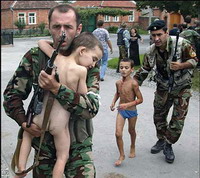Russia organizes memorial ceremony in honor of 3rd anniversary of Beslan school massacre
A memorial ceremony took place on Monday on the third anniversary of the Beslan school carnage.

Weeping townspeople laid red flowers on the floor of the school's gymnasium where more than 1,000 hostages were held during the ordeal and schoolchildren released white balloons in the memory of 334 people who died in the siege, more than half of them children.
In Moscow, President Vladimir Putin opened a Cabinet meeting with a moment of silence for the victims.
Terrorists demanding independence for the Russian republic of Chechnya stormed into the southern Russian school on Sept. 1, 2004, the first day of the school year. The siege ended two days later in a maelstrom of explosions and gunshots, but what triggered it is still hotly debated.
Authorities have suggested that the homemade bombs placed in the gymnasium by 32 heavily armed militants went off accidentally or were detonated by the militants.
However, victims and relatives of the dead, and at least one member of the parliamentary commission which investigated the siege, insisted that the explosions that sparked the maelstrom came from outside the building.
The lawmaker, Yuri Savelyev, reaffirmed Monday that the initial explosion apparently had been caused by special forces who fired grenades into the school building.
"Someone could have lost his nerve and fired a grenade-launcher," he said on the Ekho Moskvy radio, saying that the federal soldiers might have targeted a militant sniper on the school building's roof who just had killed a senior special forces officer.
Activists of the Fund for Victims of Terror led by liberal activist Marina Litvinovich on Monday took to the streets of Moscow to distribute copies of Savelyev's report.
Litvinovich said her group made the move because the state-controlled television stations and other media shunned the report. "The only means is to distribute the report to people directly and free of charge," she told the APTN.
Last month, the Beslan mothers' group released previously unseen video footage that appeared to corroborate Savelyev's conclusion.
The footage shows homemade explosive devices - bottles filled with shrapnel and ball bearings that had been hung from basketball hoops and the roof of the gymnasium.
Men, who are not shown, can be heard talking. They appear to be bomb experts and the Kommersant newspaper said they were army engineers being questioned by prosecutors.
"The holes inside (on the walls) could not have been caused by these explosives," one of the men says. "All of these (ball bearings) would have been scattered around but on the children we brought out there was no evidence of these sorts of injuries."
Only one of the attackers is known to have survived. The man, Nur-Pashi Kulayev, was sentenced to life in prison in 2006.
Subscribe to Pravda.Ru Telegram channel, Facebook, RSS!





